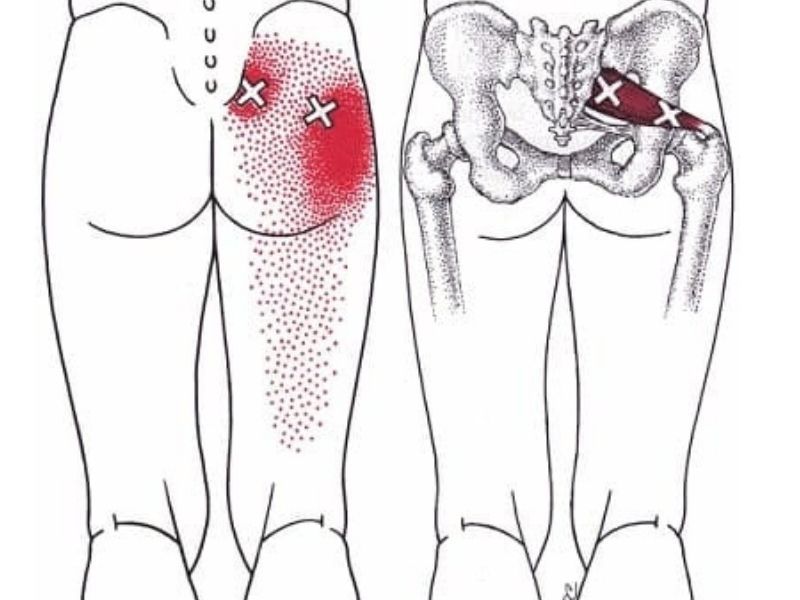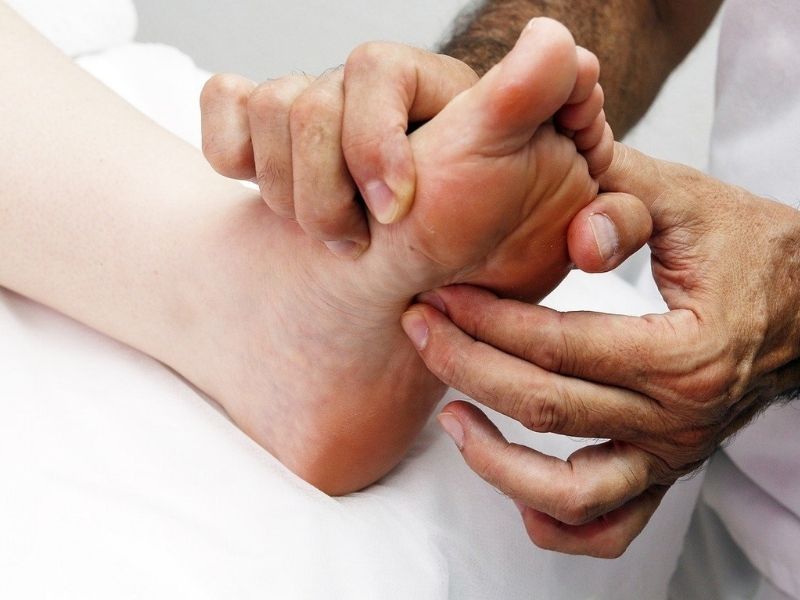Piriformis Trigger Points | How To Find And Self Treat

Table of Contents
- - Piriformis Muscle Anatomy And Function
- - Function of the Piriformis Muscle:
- - What Are Trigger Points And Why Do They Matter?
- - Main Complaints Related To Trigger Points in The Piriformis
- - Causes Of Piriformis Pain And Trigger Points
- - Piriformis Trigger Point Locations
- - How To Self-Release Piriformis Trigger Points
- - Follow Up Stretching The Piriformis
- - Follow Up Exercises For Piriformis
Dealing with persistent hip or buttock pain?
You might be experiencing the effects of piriformis trigger points. These sensitive spots within the piriformis muscle, located deep in the buttock region, can cause a myriad of symptoms, ranging from localized discomfort to radiating pain mimicking sciatica.
Armed with my personal experience as a neuromuscular therapist with over 20 years of expertise and practical knowledge at my clinic Release Muscle Therapy, I’ll guide you here on how to identify, self-treat, and prevent piriformis trigger points and related issues.
Piriformis Muscle Anatomy And Function
Location: The piriformis muscle is located deep within the buttock, situated beneath the gluteal muscles.
Origin: It originates from the anterior surface of the sacrum, which is the triangular bone at the base of the spine.
Insertion: The muscle fibers run from the sacrum and converge to attach to the greater trochanter of the femur, which is the large bony prominence located on the outer side of the upper thigh.
Relation to the Sciatic Nerve: The piriformis is closely associated with the sciatic nerve, which either runs beneath or, in some individuals, through the muscle. This close proximity is the reason why the piriformis is often implicated in sciatic pain.
Function of the Piriformis Muscle:
Lateral Rotation of the Hip: When the hip is extended, the piriformis acts primarily to laterally rotate the femur (thigh bone) in the hip joint. This means it helps turn the leg and foot outward.
Abduction of the Thigh: When the hip is flexed to 90 degrees, the piriformis acts to abduct the thigh, meaning it helps move the leg away from the midline of the body.
Stabilization: The piriformis also plays a role in stabilizing the hip joint, especially during walking or running. It helps keep the head of the femur securely within the hip socket, preventing dislocation or excessive movement.
Restraining Medial Rotation: The piriformis helps to control and limit the medial (inward) rotation of the thigh, especially during the early stance phase of gait when the foot first hits the ground during walking.
Given its role and its relation to the sciatic nerve, any dysfunction or tightness in the piriformis can lead to a range of symptoms, the most notable being “piriformis syndrome.” This syndrome arises when the muscle compresses or irritates the sciatic nerve, leading to symptoms like buttock pain that can radiate down the leg, mimicking classic sciatica.
What Are Trigger Points And Why Do They Matter?
Trigger points, often referred to as “muscle knots,” are hypersensitive, tight areas or nodules within muscle fibers. They can be felt as small, tender lumps in the muscle and are usually the result of muscle overuse, strain, or injury.
There are two main types of trigger points:
- Active Trigger Points: These cause pain at rest and when the muscle is used. The pain is usually felt at the site of the trigger point and can also radiate to other areas. This referred pain can sometimes follow specific patterns.
- Latent Trigger Points: These are dormant and don’t cause spontaneous pain, but they can restrict movement and cause muscle weakness. When pressed or stretched, they can become painful.
Active trigger points are notorious for causing persistent pain, which can manifest as sharp, dull, burning, or aching sensations. This pain is sometimes so unique that it’s mistaken for other conditions, leading to potential misdiagnosis. But the implications of trigger points don’t stop at mere discomfort.
They can significantly impact the range of motion in joints due to the pain and muscle tightness they induce. Over prolonged periods, this limitation can escalate into joint stiffness and a noticeable decline in functionality.
Moreover, muscles plagued with active trigger points don’t operate at their best, resulting in muscle weakness and quick fatigue. One of the hallmark features of trigger points is their capability to refer pain to distant regions of the body.
For example, those present in the neck might be the culprits behind recurring headaches. Chronic presence of these trigger points, especially in pivotal muscles like those in the back and neck, can lead to postural anomalies as the body constantly tries to adjust and compensate for the pain and imbalance.
To add to this, the consistent pain and discomfort stemming from these trigger points can be a significant disruptor of sleep, causing conditions like insomnia or sporadic sleep patterns.
Main Complaints Related To Trigger Points in The Piriformis
Trigger points in the piriformis muscle can lead to a variety of symptoms and complaints. The piriformis muscle, due to its proximity to the sciatic nerve, can have a profound impact when these trigger points become active. Here are the main complaints related to trigger points in the piriformis:
- Buttock Pain: One of the most common complaints is a deep, aching pain in the buttock on the affected side. This pain can sometimes be sharp or radiating.
- Sciatica-like Symptoms: The sciatic nerve runs very close to or even through the piriformis muscle in some individuals. When the piriformis muscle becomes tight or inflamed due to trigger points, it can compress or irritate the sciatic nerve. This can lead to symptoms that mimic sciatica, such as radiating pain, tingling, or numbness that travels down the leg, sometimes reaching as far as the foot.
- Reduced Range of Hip Motion: The tightness and discomfort caused by the trigger points can lead to a reduction in the range of motion of the hip joint, making movements like hip rotation painful.
- Referred Pain: Trigger points in the piriformis can also cause referred pain to other areas, such as the lower back or the other regions of the buttock.
- Difficulty Sitting: Due to the location of the piriformis, sitting for extended periods, especially on hard surfaces, can exacerbate the pain and discomfort.
- Pain While Walking: Walking, especially for long distances, can become painful due to the involvement of the piriformis in hip stabilization and movement.
- Piriformis Syndrome: This is a condition where the piriformis muscle compresses the sciatic nerve, leading to a range of symptoms including pain, numbness, and tingling. While piriformis syndrome can have other causes, trigger points in the piriformis are a common culprit.
- Pain During Certain Activities: Activities that put strain on the piriformis, such as climbing stairs, running, or even crossing legs, can become painful when there are active trigger points in the muscle.
Causes Of Piriformis Pain And Trigger Points
Piriformis pain and the development of trigger points in the muscle can arise from various causes. One of the primary culprits is muscle overuse or strain, often seen in athletes or individuals who engage in activities requiring repetitive hip rotation or sudden changes in direction.
Direct trauma or injury to the buttock area, such as from a fall or a car accident, can lead to inflammation and tightness in the piriformis, fostering the formation of trigger points. Prolonged sitting, especially on hard or uneven surfaces, can put constant pressure on the muscle, leading to discomfort and potential trigger point development.
Furthermore, anatomical variations where the sciatic nerve runs through the piriformis muscle, rather than beneath it, can make some individuals more susceptible to piriformis syndrome, with the muscle compressing the nerve when it becomes tight or inflamed.
Additionally, imbalances in posture or gait, often stemming from issues in adjacent muscles or joints, can place undue stress on the piriformis, contributing to pain and the onset of trigger points.
It’s also worth noting that other conditions, like lumbar spine issues or hip disorders, can refer pain to the piriformis region, making it essential to obtain a comprehensive diagnosis to pinpoint the exact cause of the discomfort.
Piriformis Trigger Point Locations

The piriformis muscle, given its relatively small size but significant depth, can house multiple trigger points. The exact number and precise location can vary among individuals, but typically, the trigger points in the piriformis muscle are found in the following areas:
- Medial Trigger Point: Located closer to the sacrum, this trigger point is found near the muscle’s origin on the anterior surface of the sacrum. It’s often the most medial of the piriformis trigger points.
- Central Trigger Point: Positioned roughly in the middle of the muscle belly, this trigger point is typically the most prominent and can be the primary source of referred pain patterns associated with the piriformis.
- Lateral Trigger Point: Located closer to the greater trochanter of the femur where the piriformis inserts, this trigger point is the most lateral and can sometimes be the source of pain that radiates down the leg.
When palpating (feeling) for these trigger points, one might feel taut bands or nodules within the muscle, which are hypersensitive to pressure. Applying pressure to these points can reproduce the pain or refer pain to other areas, a characteristic feature of trigger points.
It’s essential to approach piriformis trigger points with care, given the muscle’s proximity to the sciatic nerve. Proper assessment and treatment by trained professionals can ensure that the nerve is not inadvertently irritated during the process.
How To Self-Release Piriformis Trigger Points
VIDEO
For those grappling with the discomfort of piriformis trigger points, several self-release techniques can provide relief right at home. One of the most popular methods involves using a foam roller.
By sitting on the foam roller and positioning it under the buttock of the affected side, individuals can gently roll back and forth, applying sustained pressure on tender areas to help release muscle tightness.
Another effective tool is a tennis or lacrosse ball.
By placing the ball under the buttock and leaning into it, one can target specific trigger points more precisely, applying pressure and making small circular movements to aid in the release.
Follow Up Stretching The Piriformis
VIDEO
Stretching the piriformis after trigger point release is vital. The process not only ensures the muscle retains its relaxed state, preventing re-tightening, but also boosts blood flow, speeding up recovery and delivering essential nutrients.
Enhanced circulation reduces the risk of future trigger points, while a flexible piriformis functions more efficiently, reducing potential injuries. Additionally, while the release targets specific muscle knots, stretching provides overall muscle relaxation.
This combined approach not only addresses immediate discomfort but also promotes long-term muscle health and reduces referred pain, offering a comprehensive solution for muscle care.
Follow Up Exercises For Piriformis
Post-trigger point release, follow-up exercises for the piriformis are paramount to ensure sustained muscle health and functionality. While the release targets immediate tension and discomfort, exercises play a pivotal role in reinforcing muscle strength, endurance, and coordination.
By actively engaging the piriformis and its neighboring muscles, these exercises foster muscle memory, ensuring the piriformis operates in harmony with surrounding structures.
This not only reduces the risk of muscle imbalances, which can be a precursor to injuries and strain, but also supports optimal hip and pelvic mechanics during daily activities. Moreover, consistent exercises act as a preventive measure, deterring the re-emergence of trigger points by keeping the muscle active and well-circulated.
In essence, while trigger point release provides immediate relief, follow-up exercises lay the foundation for long-term piriformis health and optimal biomechanical function.
Sam Visnic
I’ve spent my life studying the fundamental aspects of human health with a focus on movement and clinical massage therapy. In a world of specialists, surgical procedures, drugs and quick fix remedies, I’m committed to finding and developing strategies that help people stuck at the “gap”. Over the last 20 years I’ve studied dozens of systems and methodologies for uncovering the root cause of aches and pains, along with postural and movement issues. Pain science, the art and science of hands-on soft tissue massage techniques, myofascial release, and coaching movement is essential in my practice. Integrating different methods but above all deciphering WHEN to use different techniques with different people and situations, along with integration of movements that people want to be able to do again is the key to long term success with my incredible track record with clients. Understanding the various elements that contribute to conditions and the power of communication and education makes my Release Muscle Therapy program separate from other hands-on therapy approaches.
Blogs You May Be Interested In
Categories
-
Deep Gluteal Pain Syndrome
-
Deltoids
-
Fallbrook
-
Foam Rolling
-
Glutes
-
Hamstrings
-
Hypnosis For Pain
-
Lats
-
Levator Scapulae
-
Lifestyle
-
Massage Therapy
-
Mobility
-
Movement and Exercise
-
Murrieta
-
Muscles
-
Nutrition
-
Obliques
-
Pain
-
Pectorals
-
Piriformis
-
Plantar Fasciitis
-
Product Review
-
Psoas
-
Quadratus Lumborum
-
Quadriceps
-
Rhomboids
-
Serratus Anterior
-
SI Joint
-
Sternocleidomastoid
-
Stretching
-
Subscapularis
-
Temecula
-
TMJ
-
Trapezius
-
Uncategorized
















